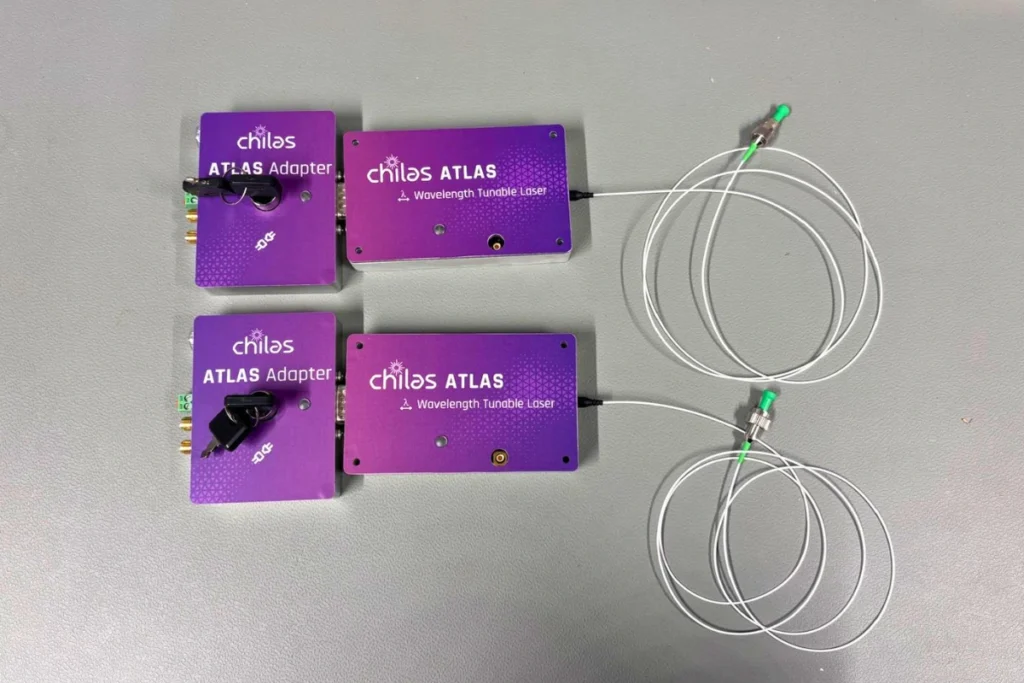Stable Wave Generation Using Two ATLAS1550 Tunable Lasers
Almost a year ago, we introduced the revamped versions of our tunable lasers, including Chilas ATLAS, a wavelength tunable lasers available in multiple configurations. In this article, we take a closer look at ATLAS1550, a tunable laser centered at 1550 nm with a tuning range of 100 nm and demonstrate how two of these lasers can be used to generate waves through optical beating.

Generating Waves from Light
Due to the tuneability, low linewidth and stability of the lasers, a beat note using two ATLAS lasers can be created in several frequency domains.
➤ MHz wave generation is highly important in RF-communication.
➤ THz wave generation can be used for gas sensing, amongst other applications.
In this experiment, we demonstrate the capabilities of MHz wave generation and modulation, a 250 MHz wave will be generated and modulated in the order of 100 MHz.
Experimental Setup
To set-up this experiment, we use two ATLAS1550 lasers. Each laser output is connected to one input of an optical fiber splitter. Both lasers are tuned to 1550 nm, with a wavelength difference of two picometers, equalling to a difference of 250 MHz. The output of the splitter is connected to a photodetector, and finally to an oscilloscope to display the wave. To modulate the beat note, a wave generator is connected to the SMB modulation port of one of the ATLAS lasers and turned on to modulate the injection current.

Stable and Accurate Beat Note Generation
The figure shows the measurement results. The two lasers create a beat frequency at 250 MHz, shown in the yellow graph.
The peak has a random drift of less than +/- 10 MHz, making the ATLAS laser suitable for wave generation well below the GHz range. In the purple graph, the Max Hold is shown when the laser is modulated using a sinusoidal wave with a function generator on its modulation input. Here, the laser smoothly modulates a range of ~125 MHz, showing a square output with a low noise level. By continuously tuning both ATLAS at frequencies within 100 MHz, while having a natural frequency drift less than 10 MHz, this experiment shows the Atlas laser having a high accuracy and stability, capable of generating stable waves by beating two of the Atlas lasers.

About the ATLAS1550 Laser
ATLAS1550 is part of the Chilas ATLAS series of ultra-narrow linewidth wavelength- tunable lasers designed for high-performance applications in telecommunications, sensing, quantum, etc. It offers continuous tuning over a 100 nm range, low phase noise, and excellent long-term stability, all within a deck of cards size, fiber-coupled module. It is easy to operate and control, via the provided graphical user interface (GUI), being offered along a Python library for advanced laser control functions. ATLAS series includes other lasers at different wavelenghts (685 nm, 850 nm, 1550 nm, 1600 nm, 1700 nm).
Article written by our laser expert Wilson Tsong.
Subscribe to Chilas Newsletter!
Stay informed with the Chilas newsletter! Our bi-monthly updates bring you the latest in laser technology, including new product releases, technical insights, customer success stories, and exclusive company news.
